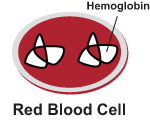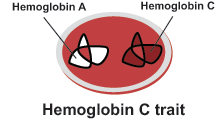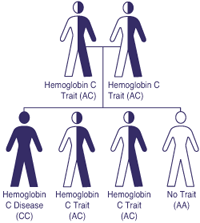Hemoglobin C Trait
What is Sickle Cell Beta Thalassemia Disease?
Hemoglobin C trait (hemoglobin C carrier) occurs when a person inherits one gene for hemoglobin C and one gene for hemoglobin A. Individuals with hemoglobin C trait are NOT at risk to develop sickle cell disease or hemoglobin C disease. They generally do NOT have any medical problems and lead normal lives.
To learn more about hemoglobin C trait, it is helpful to understand a little more about hemoglobin.
 What is Hemoglobin? What is Hemoglobin?
Hemoglobin is a protein in blood. It is found in red blood cells.
What does hemoglobin do?
Hemoglobin delivers oxygen from our lungs to all parts of our body. Oxygen helps the body make energy.
Where does hemoglobin come from?
Hemoglobin is made from a set of instructions called genes. We inherit these instructions from our parents. Our mom and dad contribute to the type of hemoglobin we inherit.
There are many different types of hemoglobin. Hemoglobin A is the most common form of hemoglobin. Other types of hemoglobin also are named using letters, including hemoglobin C. An individual with hemoglobin C trait has two types of hemoglobin, A and C, and is also known as hemoglobin AC.

How Common is Hemoglobin C Trait?
Hemoglobin C is seen most frequently among people of African descent; one in 50 African Americans have hemoglobin C trait. It also is found in people of Middle Eastern and Mediterranean descent. However, it is important to note that people of all ancestries can have hemoglobin C trait.
 How is Hemoglobin C Trait Inherited? How is Hemoglobin C Trait Inherited?
Like height and eye color, a person inherits genes that produce hemoglobin from each parent. Each person has two copies of the gene that tells the body how to make hemoglobin. One copy comes from the father and the other copy comes from the mother. Individuals with hemoglobin C trait inherited the gene for hemoglobin A from one parent and the gene for hemoglobin C from the other parent.
Why is it Important to Know if I Have Hemoglobin C Trait?
It is important to identify people who are carriers of abnormal hemoglobin, including hemoglobin C trait, so they will be aware of their risk of having children with a severe hemoglobin disease. Individuals with hemoglobin C trait can have a child with hemoglobin C disease or hemoglobin SC disease (a type of sickle cell disease). For example, if an individual with hemoglobin C trait has a child with another individual with hemoglobin C trait, there is a 25 percent chance that the child will inherit hemoglobin C disease.
If both parents are carriers of sickle cell trait or another hemoglobin change (like hemoglobin C), there is a 25 percent (or one in four) chance that they will have a child with sickle cell disease. The couple also has a 25 percent chance of having a child with regular hemoglobin (AA) and a 50 percent chance of having a child with a hemoglobin trait like the parents. It is recommended that any person who carries a hemoglobin trait meet with a genetic counselor to obtain more information.
For Additional Information
Illinois Department of Public Health
Genetics/Newborn Screening Program
535 W. Jefferson St., Second Floor
Springfield, IL 62761
217-785-8101
http://www.idph.state.il.us/HealthWellness/genetics.htm

 |
|
Illinois Department
of Public Health
535 West Jefferson Street
Springfield, Illinois 62761
Phone 217-782-4977
Fax 217-782-3987
TTY 800-547-0466
Questions or Comments |
|


 What is Hemoglobin?
What is Hemoglobin?
 How is Hemoglobin C Trait Inherited?
How is Hemoglobin C Trait Inherited?